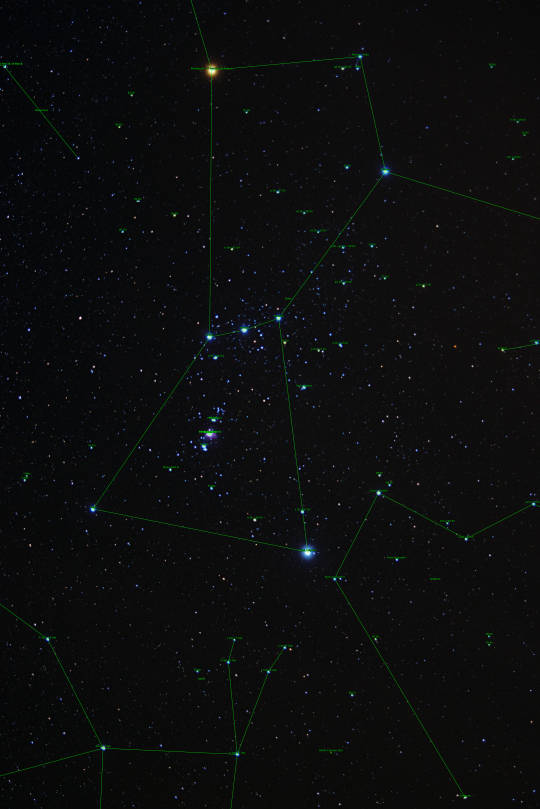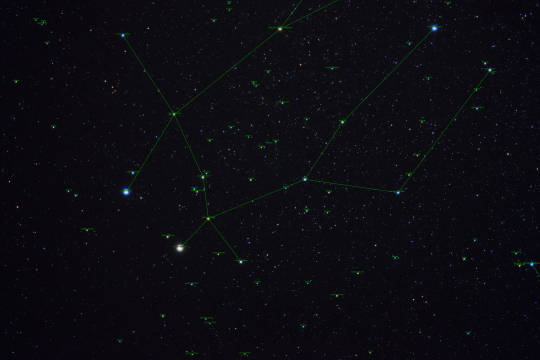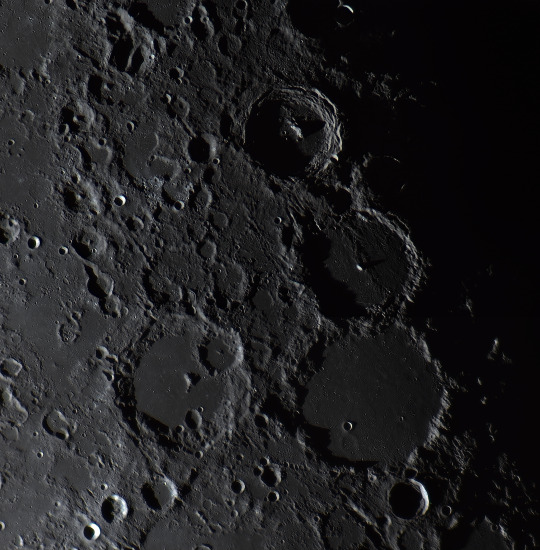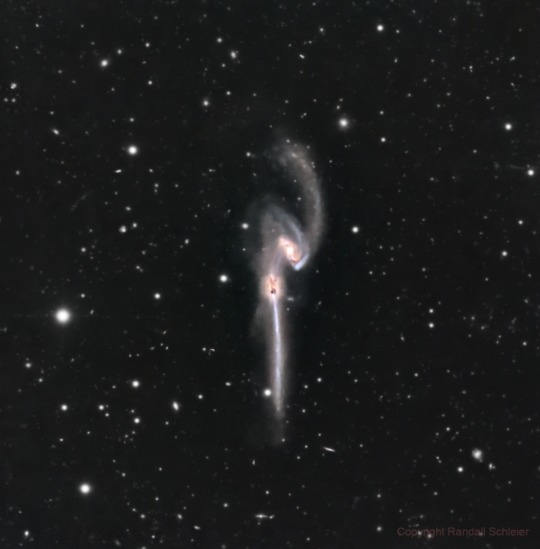Text

The Northern Jewel Box (NGC 6231, bottom) // Dawson Fehr
Also in this image is the Prawn Nebula (IC 4628), and the star clusters NGC 6281 (upper left), NGC 6268 (above left of Prawn), NGC 6242 (above right of Prawn), and NGC 6192 (bottom right)
#astronomy#astrophotography#stars#star cluster#open cluster#northern jewel box#NGC 6231#NGC 6281#NGC 6268#NGC 6242#NGC 6192#nebula#emission nebula#star-forming region#prawn nebula#IC 4628#scorpius
55 notes
·
View notes
Text

Venus (upper left) and the Pleiades (M45, bottom right) on April 12, 2023 // Dawson Fehr
#astronomy#astrophotography#solar system#planet#terrestrial planet#rocky planet#venus#stars#star cluster#open cluster#pleiades#seven sisters#subaru#messier#messier 45#M45#taurus
50 notes
·
View notes
Text

The constellation of Orion // Dawson Fehr
Read below the cut to learn more about the stars in this image!
Of course, the two brightest stars in Orion are Rigel (β Orionis) at the bottom right and Betelgeuse (α Orionis) at the top right.
Rigel is named after the Arabic word rijl, meaning "left leg". Indeed, it is the left leg of Orion. Rigel is a quadruple star system, with the primary being a blue supergiant star.
Betelgeuse is named after the Arabic phrase Yad al-Jawzā’, meaning "hand of Orion." Europeans misread the "y" sound as a "b" sound, leading to the modern name. Betelgeuse is a solitary red supergiant star.
In the middle of Orion is Orion's Belt, composed of three stars:
Alnilam (ε Orionis) is named after the Arabic phrase al-niẓām, meaning "string [of pearls]". It is a solitary blue supergiant star. It is the center star in the belt.
Alnitak (ζ Orionis) is named after the Arabic phrase an-niṭāq, meaning "the girdle." Alnitak is a triple star system, with the primary being a blue supergiant. It forms the left star in the belt.
Mintaka (δ Orionis) is named after the Arabic term manṭaqa, meaning "belt". Mintaka is a multiple star system with the primary being a blue supergiant. It forms the right star of the belt.
Other stars in Orion in this image include (from brightest to dimmest):
Bellatrix (γ Orionis), named after the Latin word bellātrix, meaning "female warrior." It is a solitary blue giant star.
Saiph (κ Orionis) comes from the Arabic phrase saif al jabbar, meaning "the saif [or sword] of the giant." Saiph is a solitary blue supergiant star.
η Orionis is a quadruple star system, with the all members being blue giant stars.
Meissa (λ Orionis) is named after the Arabic phrase Al-Maisan, meaning "the shining one." This is a multiple star system, with the primary being a blue giant star.
τ Orionis is a solitary blue giant star.
π5 Orionis is a binary star system, with the primary being a blue giant star.
π6 Orionis is a solitary red giant star.
Use this image to help you identify these stars!

#astronomy#astrophotography#constellation#star#single star#binary star#triple star#multiple star system#rigel#betelgeuse#alpha orionis#beta orionis#orion's belt#orion
100 notes
·
View notes
Text

The constellation of Gemini // Dawson Fehr
Read below the cut for info about what stars are in this image!
The two bright stars are Castor (blue) and Pollux (white). Pollux (β Geminorum) and Castor (α Geminorum) are named after the two twins from Greek mythology. Their mother was the mortal Leda, but they shared different fathers. Castor was the mortal son of Tyndareus, king of Sparta, while Pollux was the divine son of Zeus. Pollux asked Zeus to share his immortality with Castor and so they were transformed into the constellation of Gemini.
Other bright stars included in this image are (ordered from bright to dim):
Alhena (γ Geminorum), named after the Arabic phrase Al Han'ah, meaning "the brand [on the neck of the camel]". This is a binary system with the primary being a blue-white subgiant star.
Mebsuta (ε Geminorum), named after the Arabic word Mabsūṭah, referring to an outstretched lion's paw. This is a white supergiant star.
Alzirr (ξ Geminorum), named after the Arabic word al-zirr, meaning "the button." This is a potential binary system, with the primary being a white subgiant star.
Wasat (δ Geminorum), derived from an Arabic word meaning "middle." This is a triple star system, with the primary being a white subgiant star.
κ Geminorum, a white giant star in a binary system.
λ Geminorum, a blue-white giant star in a possible binary system.
θ Geminorum, a single blue-white subgiant star.
Mekbuda (ζ Geminorum), named after an Arabic phrase meaning "the lion's folded paw." It shares this derivation with ε Geminorum. This star is a white supergiant star.
υ Geminorum, a single red giant star.
τ Geminorum, a single red giant star with a Jupiter-mass exoplanet.
Here's an image to help you identify these stars!

#astronomy#astrophotography#constellation#stars#star system#binary star#triple star system#castor#pollux#alpha geminorum#beta geminorum#etymology#gemini
19 notes
·
View notes
Text

The Sun on April 23, 2024 // Steven Christensen
52 notes
·
View notes
Text

The Hercules Globular Cluster (M13) and the dust around it // seasalt.astro
#astronomy#astrophotography#stars#star cluster#globular cluster#hercules globular cluster#messier#messier 13#M13#NGC 6205#nebula#dark nebula#dust#interstellar dust#integrated flux nebula#hercules
22 notes
·
View notes
Text

The Lagoon Nebula, M8 // rallyho
#astronomy#astrophotography#nebula#emission nebula#star-forming region#lagoon nebula#messier#messier 8#M8#NGC 6523#Sh2-25#sagittarius
32 notes
·
View notes
Text

The Dark Doodad Nebula // Tak@CSLP
Note the globular cluster NGC 4372 at the bottom!
#astronomy#astrophotography#nebula#dark nebula#dust#interstellar dust#molecular cloud#dark doodad nebula#stars#star cluster#globular cluster#NGC 4372#musca
25 notes
·
View notes
Text

Four large craters on the Moon // Wilco Kasteleijn
From top to bottom left: Arzachel, Alphonsus, Ptolemaeus, and Albategnius.
Arzachel crater is named after the Arabic instrument maker Abū Isḥāq Ibrāhīm ibn Yaḥyā al-Naqqāsh al-Zarqālī al-Tujibi (1029 - 1100). His Latinized name was Arzachel, meaning "the engraver." He wrote books about constructing instruments for calculating the positions of the planets.
Alphonsus crater is named after King Alfonso X of Castile (1221-1284). He was sometimes nicknamed the Astrologer for the creation of the Alfonsine tables used to compute the position of the planets.
Ptolemaeus crater is named after the Greek philosopher Claudius Ptolemy (c. 100 - 170). Among his many accomplishments is the Almagest, the earliest surviving complete book on ancient astronomy. It also provided mathematical "proof" for the geocentric nature of the universe.
Albategnius crater is named after Abū ʿAbd Allāh Muḥammad ibn Jābir ibn Sinān al-Raqqī al-Ḥarrānī aṣ-Ṣābiʾ al-Battānī (bef. 858 - 928), one of the greatest and most famous astronomers of the medieval Islamic world. It was the accuracy of his data that later led Nicolaus Copernicus to consider a heliocentric model of the universe.
#astronomy#astrophotography#solar system#moon#the moon#luna#lunar surface#crater#lunar crater#arzachel#alphonsus#ptolemaeus#albategnius#history
19 notes
·
View notes
Text

The Mice Galaxies, NGC 4676 // Randall Schleier
#astronomy#astrophotography#galaxy#spiral galaxy#interacting galaxies#peculiar galaxy#star-forming galaxy#mice galaxies#NGC 4676#Arp 242#coma berenices
41 notes
·
View notes
Text

NGC 5248 // Greg Nelson
19 notes
·
View notes
Text

The Western Veil Nebula, NGC 6960 // Karl-Heinz Macek
The bright star is 52 Cygni which is in the foreground and unrelated to the nebula.
#astronomy#astrophotography#nebula#emission nebula#diffuse nebula#supernova remnant#veil nebula#western veil nebula#NGC 6960#star#giant star#52 cygni#cygnus
60 notes
·
View notes
Text

M106 (lower left) and NGC 4217 (upper right) // Timo Kubach
#astronomy#astrophotography#galaxy#spiral galaxy#star-forming galaxy#messier#messier 106#M106#NGC 4258#NGC 4217#canes venatici
30 notes
·
View notes
Text

The Vallis Alpes (left), Eudoxus crater (right), and Aristoteles crater (upper right) // Wilco Kasteleijn
Aristoteles crater is named after the famed Greek philosopher Aristotle (384 - 322 BC). Among his many accomplishments*, he proposed the idea that the planets revolve around the Earth embedded in perfect crystal spheres.
Eudoxus crater is named after the Greek astronomer Eudoxus of Cnidus (c. 390 - 340 BC). Building upon Aristotle's perfect circular orbits, Eudoxus explained the apparent retrograde (i.e., backwards) motion of some planets in the sky by adding additional spheres to each planet's orbit. This was a first step in the right direction.
Vallis Alpes is Latin for "Alpine Valley", since it bisects the Montes Alpes range. This valley extends about 100 miles and is about 6 miles across at its widest point.
#astronomy#astrophotography#solar system#moon#the moon#luna#lunar surface#crater#lunar crater#aristoteles#eudoxus#aristotle#vallis alpes#history
22 notes
·
View notes
Text

The Draco Triplet, part of the NGC 5982 Group // Hisatarou
From left to right: NGC 5985, NGC 5982, and NGC 5981.
#astronomy#astrophotography#galaxy group#NGC 5982 Group#draco triplet#galaxy#spiral galaxy#elliptical galaxy#star-forming galaxy#NGC 5985#NGC 5982#NGC 5981#draco
46 notes
·
View notes
Text

NGC 1333 // Phil Brewer
#astronomy#astrophotography#nebula#reflection nebula#dust#interstellar dust#molecular cloud#NGC 1333#perseus
32 notes
·
View notes
Text

A zoom-in of the Carina Nebula (NGC 3372) // Peter Merrick
The bright star upper left of center is none other than η Carinae, a highly luminous hypergiant star with a mass between 100-150 times that of our Sun!
Surrounding η Carinae is the Homunculus Nebula, ionized gas that is believed to have erupted from η Carinae itself in 1841. This made it one of the brightest stars in the night sky, outshining Rigel in Orion.
#astronomy#astrophotography#nebula#emission nebula#star-forming region#carina nebula#NGC 3372#star#star system#binary star#eta carinae#hypergiant#carina
38 notes
·
View notes